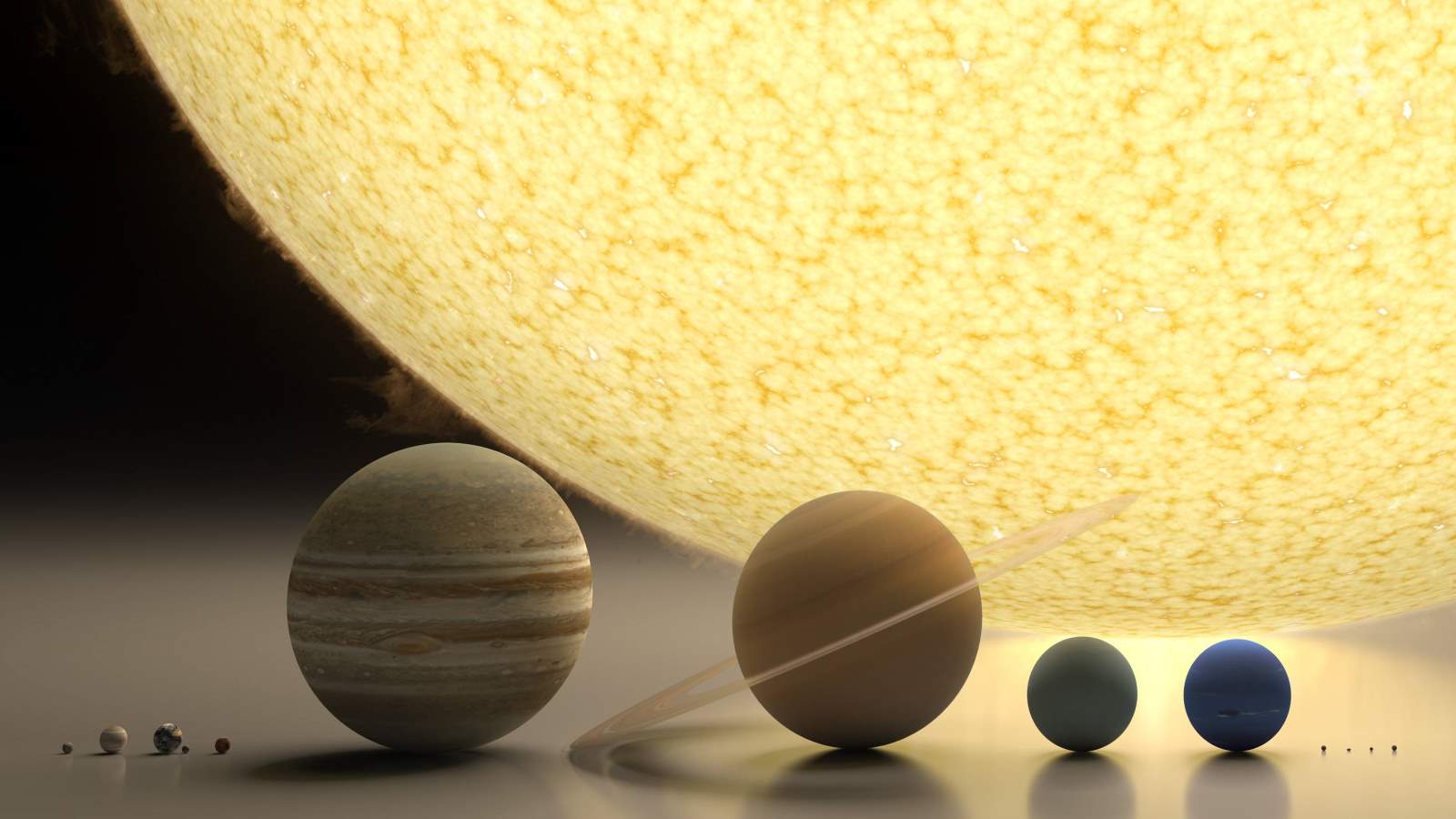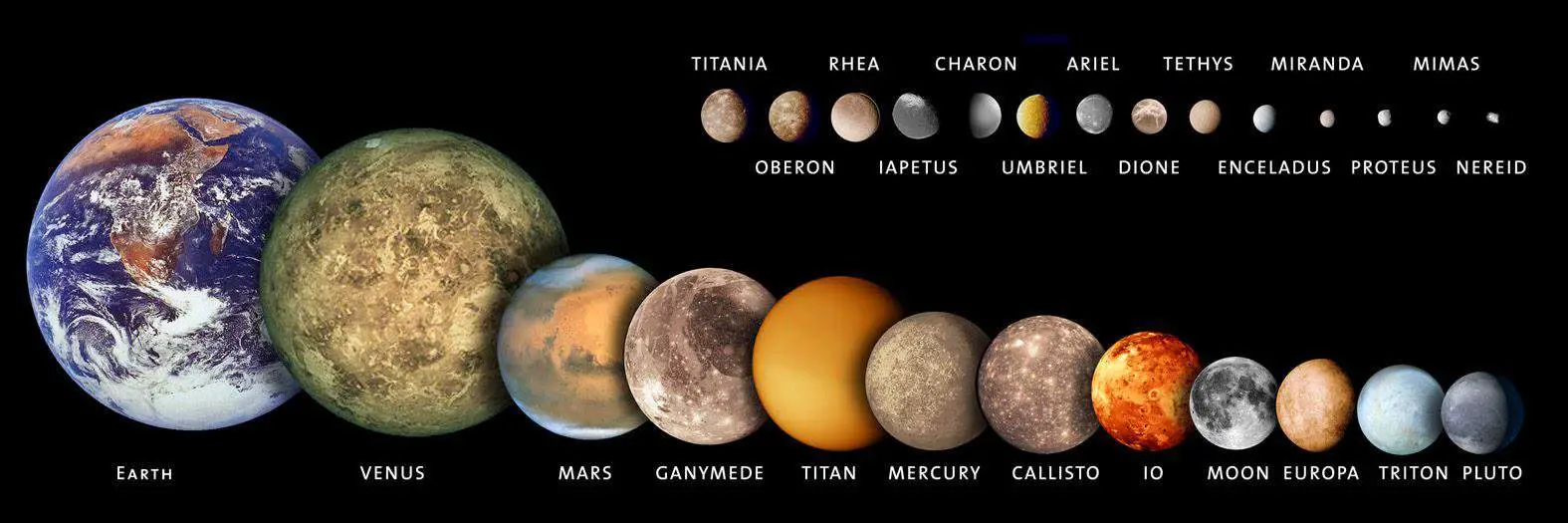This size comparison of the Sun and the planets in our solar system is going around frequently, but it’s still amazing to see it. Created by the San Francisco-based artist Roberto Ziche, the image features the Sun in the background with the planets, Moon, and the four dwarf planets lined up in the foreground in the relative scale of size to one another.

Ziche says:
“At the Chabot Space and Science Center there were some old, poor quality images, probably downloaded from the Internet and printed on office paper, showing the Sun and the planets to scale.”
“I found the images content to be extremely interesting, but the design and quality was definitely something that could have been improved”.
“I decided to give it a try, and create a brand new, more artistic view of our solar system, poster size (36″x36″), and donate it to the Center to replace those old prints.”
“The 3D geometry was not too complex, but there was a lot of lighting experimentation to get the scene illuminated only by the Sun itself, and some time consuming multi-layer composition in Photoshop.”
Size comparison of the Sun, planets, and dwarf planets
The radiuses of the celestial bodies in the image (from left to right):
Sun
Approximately 695,700 km (432,300 mi)
Planets (and moon)
- Mercury: 2,440 km (1,516 mi)
- Venus: 6,052 km (3,760 mi)
- Earth: 6,371 km (3,959 mi)
- Moon: 1,737 km (1,079 mi)
- Mars: 3,390 km (2,106 mi)
- Jupiter: 69,911 km (43,441 mi)
- Saturn: 58,232 km (36,184 mi)
- Uranus: 25,362 km (15,759 mi)
- Neptune: 24,622 km (15,299 mi)
Dwarf Planets
- Pluto: 1,188 km (738 mi)
- Haumea: 816 km (507 mi)
- MakeMake: 750 km (466 mi)
- Eris: 1,186 km (737 mi)
Haumea
Originally designated 2003 EL61 (and nicknamed Santa by one discovery team), Haumea resides in the Kuiper belt, a region outside the orbit of Neptune. In other words, it is a trans-Neptunian object (TNO), like Pluto, Makemake, and Eris in the illustration above.
It is one of the fastest-rotating large objects in our solar system. Its fast spin distorts Haumea’s shape, making this dwarf planet look like a football. It was discovered in 2004 by a team headed by Mike Brown of Caltech (the Pluto-killer himself) at the Palomar Observatory in the United States and independently in 2005, by a team headed by José Luis Ortiz Moreno at the Sierra Nevada Observatory in Spain. Haumea was named after the Hawaiian goddess of fertility.
Makemake
Along with fellow dwarf planets Pluto, Eris, and Haumea, Makemake is also located in the Kuiper Belt. Slightly smaller than Pluto, Makemake is the second-brightest object in the Kuiper Belt as seen from Earth (while Pluto is the brightest). It takes about 305 Earth years for this dwarf planet to make one trip around the sun.
Eris
Originally designated 2003 UB313 (and nicknamed for the television warrior Xena by its discovery team), it is one of the largest known dwarf planets in our solar system. It’s about the same size as Pluto but is three times farther from the Sun.
Eris first appeared to be larger than Pluto. This triggered a debate in the scientific community that led to the International Astronomical Union’s decision in 2006 to clarify the definition of a planet. Pluto, Eris, and other similar objects are now classified as dwarf planets.
Observations of a stellar occultation by Eris in 2010, showed that its diameter was 2,326 ± 12 kilometers (1,445.3 ± 7.5 mi), very slightly less than Pluto, which was measured by New Horizons as 2,372 ± 4 kilometers (1,473.9 ± 2.5 mi) in July 2015.
Eris is named for the ancient Greek goddess of discord and strife.
Sources
- Haumea on the NASA website
- Makemake on the NASA website
- Eris on the NASA website
- Eris on Wikipedia
- How Many Elephants are Left in the World in 2025? - August 17, 2025
- Moon Landings: All-Time List [1966-2025] - February 2, 2025
- What Is Max-Q and Why Is It Important During Rocket Launches? - January 16, 2025

5 replies on “Size Comparison of the Sun and the Planets”
Mind Blown!!!!
Jupiter is 1/10 the size of the Sun yet you wouldn’t know it based on this photo.
Seems just about right for just under 10x…
https://ibb.co/vByk91Z
over 900 Jupiters will fit inside the sun
This is cool, except you left out Ceres, the only dwarf planet that is in the Asteroid Belt.